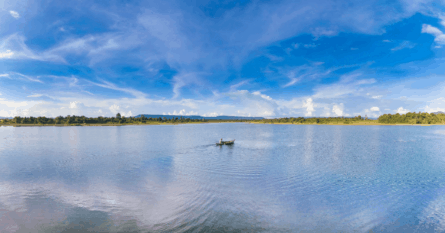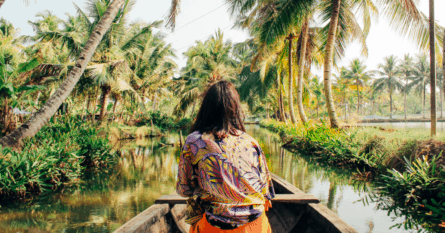Estimated reading time: 13 minutes
Love traveling and want to help the planet? Check out our guide to ecotourism and learn how you can visit stunning natural destinations while supporting conservation and sustainable development.

As more and more travelers seek to reduce their environmental impact, ecotourism has emerged as a popular way to explore nature responsibly. This type of travel prioritizes practices that minimize negative effects on the environment and benefit local communities. In this article, we’ll delve into ecotourism’s main benefits and highlight some of the world’s top places for eco-conscious travelers.
What Is Ecotourism
Ecotourism is a form of sustainable tourism that promotes responsible travel to nature while minimizing negative impacts on the environment and supporting the well-being of local communities. It is mainly characterized by its focus on conservation, education, and community involvement. Ecotourism activities typically include visiting natural areas such as national parks, wildlife reserves, and forests and can contain activities such as birdwatching, hiking, and wildlife photography. The primary goal of ecotourism is to provide an immersive experience for visitors to appreciate and learn about the natural world, while at the same time contributing to conservation efforts and local economies.
Benefits of Ecotourism
Traditional tourism often prioritizes profit over environmental and cultural sustainability, leading to negative impacts on local communities, ecosystems, and cultural heritage sites. For instance, Bali, Indonesia, has suffered from significant over-tourism in recent years, resulting in environmental degradation, overcrowding, and strain on the island’s infrastructure. Similarly, native Hawaiians have been calling for tourists to respect their culture and the environment by avoiding certain sacred sites, such as the summit of Mauna Kea. Additionally, the high volume of visitors to Machu Picchu in Peru has led to littering, overcrowding, and damage to the ancient ruins, prompting the Peruvian government to limit the number of daily visitors and implement other measures to protect the site.
However, ecotourism offers a more responsible and sustainable alternative that can mitigate these issues. By focusing on reducing pollution and waste, educating travelers about conservation efforts, and supporting local economies, ecotourism not only protects the environment but also fosters a deeper understanding and appreciation of the places being visited.
Another significant benefit of ecotourism is its potential to educate travelers about the importance of preserving nature and protecting wildlife habitats. It allows visitors to learn more about the environment they are visiting while assisting with conservation efforts, like beach cleanups or tree planting initiatives. These educational experiences can also inspire travelers to adopt positive behavior in their everyday lives, such as by making a more conscious effort to assist with conservation and sustainability.
In addition to environmental benefits, ecotourism can also bring positive impacts to local communities. It can create jobs and income opportunities for people living near tourist destinations, supporting local economies. By participating in ecotourism activities, travelers can also encourage governments, businesses, charitable organizations, and others to take conservation efforts seriously.
Furthermore, ecotourists have the opportunity to learn about a culture’s customs, beliefs, and food habits, which helps to broaden their perspectives and understanding of different ways of life. Also, tourists in areas that have not historically been tourist hotspots can help locals learn new skills, such as hospitality or language skills.
Top Ecotourism Destinations for Responsible Travelers
Now that you know how ecotourism can make a positive impact on the environment and local communities, it’s time to explore some of the world’s most breathtaking and responsible travel destinations.
Galapagos Islands
The Galapagos Islands, located off the coast of Ecuador, are a once-in-a-lifetime ecotourism destination. Designated as the first UNESCO World Heritage Site, the islands boast an exceptional ecosystem that cannot be found anywhere else in the world.

Galapagos is home to a variety of unique species, including giant tortoises, marine iguanas, and blue-footed boobies, among others. Due to their isolated location, the animals have evolved into new species over time, making the Galapagos a living laboratory of evolution. Actually, the flora and fauna found here have played an important role in educating the world about our planet and inspiring Charles Darwin to develop his theory of evolution. The protected waters surrounding the islands offer visitors the chance to swim with sharks, sea turtles, and sea lions, among other marine life.
Although tourism once threatened the islands, they are no longer listed as ‘in danger’ thanks to strong management and continued stewardship from the government, NGOs, and the local community, who work to build the most sustainable tourism sector that has ever existed. However, all visitors should be aware of the possible by-products of irresponsible tourism, such as contamination from boat oil, the introduction of non-native species, and overconsumption of the freshwater supply, and take measures to ensure they don’t unwittingly harm the land.
If you’re looking for an all-in-one experience that combines lodging and tours, the Galapagos Safari Camp is a great choice. This eco-lodge offers deluxe tented accommodations in the midst of the island’s natural landscapes and also provides a range of guided tours and activities to explore the Galapagos. Another option is the Santa Cruz II, a luxury expedition vessel that provides a comfortable base for exploring the islands with daily guided excursions and activities, including snorkeling and kayaking.
The Amazon rainforest is an ecological marvel that has millions of species of plants and animals, including some that have yet to be discovered. It is a biodiverse wonderland that covers an area of 5.5 million square kilometers and is spread across nine South American countries. The Amazon has been called the lungs of the planet because it produces over 20% of the world’s oxygen. In addition, it acts as a natural carbon sink, helping to regulate the Earth’s climate.
Amazon rainforest
There is something for every type of traveler in the Amazon. Adventure seekers can embark on a jungle trek, canoe down the river, or try their hand at piranha fishing. Wildlife lovers can spot exotic species such as jaguars, pink river dolphins, and giant otters. Cultural enthusiasts can learn about the indigenous tribes that call the Amazon home and their way of life. For those seeking a more relaxed experience, they can take a leisurely boat ride down the river and enjoy the breathtaking views.

Historically, ecotourism in the Amazon was primarily led by indigenous individuals who sought to replace more destructive forms of tourism and educate visitors about local customs and practices. Today ecotourism is a powerful tool in the battle to protect the Amazon rainforest from deforestation, illegal logging, and climate change. This sustainable tourism practice can offer a viable source of income for local communities, thereby reducing their dependence on activities like logging and farming that can be detrimental to the forest’s health. Moreover, ecotourism can help to facilitate cultural exchange and understanding by supporting local businesses and employing native guides, which may ultimately help to prevent conflict between indigenous communities and outsiders.
For a truly immersive experience in the Amazon rainforest, consider staying at one of the many eco-lodges in the area. The Napo Wildlife Center, located in the Ecuadorian Amazon, offers comfortable accommodations and guided excursions that allow visitors to explore the surrounding jungle while supporting the local community. Alternatively, the Uakari Lodge in Brazil offers a unique opportunity to see the critically endangered red uakari monkey, while also practicing sustainable tourism. Another option is the Inkaterra Reserva Amazonica in Peru, which offers luxury accommodations and various activities such as wildlife watching, rainforest canopy walks, and visits to nearby native communities.
Costa Rica
Costa Rica is a well-known ecotourism destination that offers visitors a chance to experience the pure life or “pura vida” lifestyle surrounded by nature. Over 25% of the country is dedicated to national parks, wildlife reserves, and protected lands, showcasing the country’s commitment to conservation.

Corcovado National Park is an absolute paradise for nature lovers, earning the title of “the most biologically intense place on earth” by National Geographic. This 400 square kilometers park is a treasure trove of biodiversity, boasting 13 different ecosystems within its boundaries, from lowland tropical rainforests to highland cloud forests, mangrove swamps, and sandy beaches. And if that isn’t enough to get you excited, the park is home to a spectacular array of wildlife, including four different monkey species, sloths, anteaters, and collared peccaries. Keep your eyes peeled and you may even spot whales, dolphins, and other marine mammals offshore. Corcovado is also home to endangered species like the Baird’s Tapir, jaguars, and Harpy Eagles, making it an ideal destination for wildlife photographers and environmental explorers.
For those who want to do more than just sightseeing, Costa Rica offers plenty of opportunities to get involved in ecotourism through volunteering. Visitors can volunteer with local coffee farmers and learn about sustainable farming practices, contributing to the country’s efforts toward sustainability. Sea turtle conservation programs are also a popular option for volunteers, where they can participate in the protection and conservation of these majestic creatures.
Eco travelers can choose from a variety of lodging options, including eco-lodges, boutique hotels, and sustainable resorts. The Pacuare Lodge offers a unique experience with its remote location accessible only by rafting down the Pacuare River, while Lapa Rios Ecolodge provides ocean and rainforest views from its private bungalows. For those seeking a luxurious getaway, the Nayara Resort Spa & Gardens offers a range of amenities such as hot springs, spas, and private villas surrounded by lush gardens.
Kenya
Kenya is a true gem when it comes to ecotourism in Africa. With its diverse natural landscapes ranging from the famous Masai Mara plains to stunning mountains, pristine beaches, and offshore coral reefs, Kenya offers an unparalleled experience for eco-travelers. The country boasts 54 national parks, which attract over a million tourists every year, making it one of the most popular destinations for ecotourism in Africa.

One of the main attractions for tourists is the opportunity to experience grassland safaris and get up close and personal with some of the world’s most impressive animals such as giraffes, lions, and rhinos. However, with this increase in tourism comes the responsibility to protect the natural environment and the wildlife that inhabits it. The Kenyan government has taken an active role in protecting its natural heritage by stopping illegal poaching, banning single-use plastics, and promoting sustainable tourism practices.
To further promote sustainable tourism, the government has established an organization called “Ecotourism Kenya.” This organization is dedicated to promoting responsible tourism that conserves Kenya’s natural environment and improves the livelihoods of local communities. By partnering with local communities, the organization ensures that they are involved in the tourism industry and reap the benefits of a thriving tourism sector while also preserving their cultural heritage and natural resources.
In addition to the wildlife and natural landscapes, Kenya’s cultural diversity also makes it a unique ecotourism destination. Visitors can explore and engage with the traditional lifestyle of the Maasai people, learning about their rich history and customs. They can also participate in community-based tourism activities such as beadwork, pottery, and traditional dances.
For travelers on a budget, there are many affordable options, such as camping in public campsites or staying in budget-friendly guesthouses like the Wildebeest Eco Camp or the Karen Camp. Additionally, for those who want a more authentic and immersive experience, there are community-owned lodges like the Maasai Mara Wilderness Conservancy or the Ol Pejeta Conservancy, which feature excellent opportunities to interact with local people, learn about their cultures, and participate in conservation efforts.
Bhutan
Nestled in the majestic Himalayan Mountains and flanked by India and China lies Bhutan, a land steeped in ancient traditions and shrouded in mystery. For centuries, Bhutan had isolated itself from the rest of the world, but today, it is renowned as one of the best examples of ecotourism destinations.

Bhutan’s focus on history and nature allows visitors to experience sacred Buddhist sites and wildlife parks teeming with unique species such as the Himalayan black bear, takin, red panda, and Tibetan wolf. The country’s emphasis on sustainability and preservation of its natural and cultural heritage is a testament to Bhutan’s dedication to environmental conservation.
Since 1991, Bhutan has implemented a daily Sustainable Development Fee for tourists, which was originally 65 USD per day, but has risen to 200 USD per day in 2022. Though the fee may seem steep, the incredible outcomes that it has produced are worth the cost. The money collected from the fee is used for funding projects such as offsetting Bhutan’s carbon footprint from tourism, supporting community education, organic farming, and upskilling workers in the tourism industry.
If you’re planning a trip to Bhutan, you’ll find a range of accommodations to suit your preferences. The Amankora Resorts presents unparalleled Himalayan views and top-notch amenities in a luxury setting. If you’re looking for an eco-friendly and affordable option, Gangtey Lodge is a great choice. This lodge seamlessly blends modern comforts with traditional Bhutanese architecture, all while prioritizing sustainable tourism practices.
A journey to Bhutan may come with a price tag, but the value of experiencing its distinctive environment and culture, all while contributing to its conservation, is truly priceless.
Iceland
Iceland is a shining example of ecotourism in Northern Europe, with a strong commitment to sustainability and environmental protection. As the cleanest energy consumer in the world, taking 75% of its usage from renewable sources, Iceland is a global leader in environmental policies.

The breathtaking landscapes of Iceland are the main attraction for eco-tourists. This is one of the last untouched destinations on earth, with inspiring scenery at every turn. Between waterfalls, glaciers, dramatic fjords, volcanoes, cracked lava fields, gushing geysers, and geothermal lagoons, Iceland is a country defined by its outdoors. Visitors can enjoy a range of adventurous activities such as white water rafting, horse riding, caving, quad bikes, and glacier climbing, all while maintaining a sustainable and responsible approach.
The tourism industry in Iceland has grown rapidly in recent years. Despite this growth, the industry remains committed to responsible tourism, ensuring that visitors can experience the beauty of the Aurora borealis, Blue Lagoon, and Gulfoss waterfalls without harming the delicate ecological balance.
Aside from its natural wonders, Iceland has a wide selection of lodging options for travelers. The Ion Adventure Hotel with its prime location and contemporary design, guarantees a memorable stay. Alternative accommodations include hostels like Kex Hotel or campsites such as Skjol, which offer a spacious and comfortable atmosphere at a reasonable price.
Norway
Norway is a top ecotourism destination that boasts some of the most stunning natural landscapes in the world. From picturesque fjords to snow-capped mountains and endless beaches, Norway’s scenery is truly breathtaking.

One of the must-visit destinations in Norway is the Geirangerfjord, a UNESCO World Heritage-listed area that features a beautiful blue fjord set against a backdrop of majestic mountains. Here, visitors can witness the true wonder of nature, with diverse wildlife and a series of offshore islands at Lofoten, where eagles, seals, and porpoises can be spotted.
For adventure seekers, Jotunheimen National Park is a haven, with towering peaks, vast glaciers, and pristine lakes, offering the perfect opportunity for activities like hiking, kayaking, skiing, and cruising through the fjords. The park is also home to rare species such as the arctic fox, reindeer, and wolverine, making it an ideal destination for wildlife enthusiasts.
Norway’s impressive sustainable policies have played a significant role in preserving its natural beauty. The government has implemented strict regulations on hunting, fishing, and oil companies. Furthermore, Norway has become one of the Global Sustainable Tourism Council pilot destinations. Inclusion on the Global Sustainable Tourism Council’s model list means that Norway has met rigorous sustainability criteria across all aspects of its tourism industry, from environmental protection to community development and cultural preservation.
Norway has a lot to offer in terms of natural beauty, so it’s worth considering extending your stay to make the most of its majestic landscapes and scenery. For sustainable accommodation, we recommend Juvet Landscape Hotel, which is located in the beautiful natural surroundings of Valldal. For a bit of an upscale experience consider staying at the historic Hotel Continental in Oslo, which offers a sophisticated ambiance with state-of-the-art facilities.
Leave Behind Only Footprints and Happy Memories
Safety, reliability, and comfort are pillars of Blacklane’s service. You’ll be chauffeured by professional drivers in meticulously maintained vehicles. Each ride offers privacy and comfort, enabling you to relax or continue working while on the move. Also, with a transparent pricing model that includes all taxes and tolls, Blacklane provides you with peace of mind, making it an attractive alternative to short-haul flights.
Moreover, Blacklane champions sustainability: all rides are 100% carbon offset, and in select cities, electric vehicles are available, allowing you to boost your environmental stewardship.
Choose Blacklane for your next journey and experience the pinnacle of efficient, eco-friendly, and enjoyable travel.



